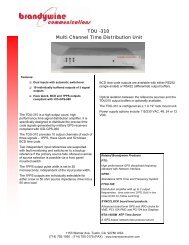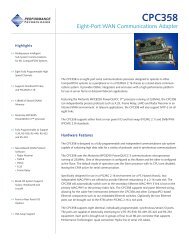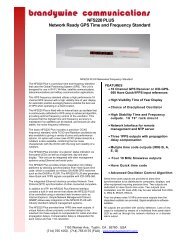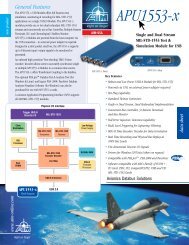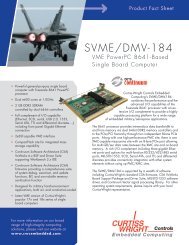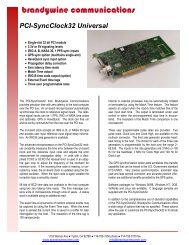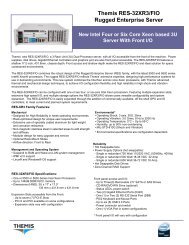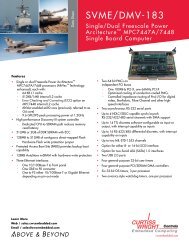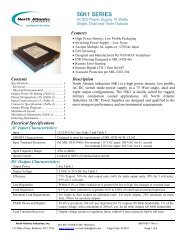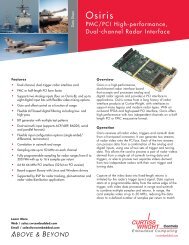PQI StandardII ICF Card 128MB~8GB WideTemp - Unitronix
PQI StandardII ICF Card 128MB~8GB WideTemp - Unitronix
PQI StandardII ICF Card 128MB~8GB WideTemp - Unitronix
Create successful ePaper yourself
Turn your PDF publications into a flip-book with our unique Google optimized e-Paper software.
Datasheet<br />
Signal Name Dir. Pin No. Description<br />
-WAIT<br />
(PC <strong>Card</strong> Memory Mode)<br />
-WAIT<br />
(PC <strong>Card</strong> Memory Mode)<br />
IORDY<br />
(True IDE mode – Except<br />
Ultra DMA mode)<br />
-DDMARDY<br />
(True IDE mode – Ultra DMA<br />
Write mode)<br />
-DSTROBE<br />
(True IDE mode – Ultra DMA<br />
Read mode)<br />
-WE<br />
(PC <strong>Card</strong> Memory Mode)<br />
-WE<br />
(PC <strong>Card</strong> I/O Mode)<br />
-WE<br />
(True IDE Mode)<br />
WP<br />
(PC <strong>Card</strong> Memory Mode)<br />
-IOIS16<br />
(PC <strong>Card</strong> I/O Mode)<br />
-IOIS16<br />
(True IDE Mode)<br />
O 42 The -WAIT signal is driven low by the CompactFlash Storage <strong>Card</strong> or CF+<br />
<strong>Card</strong> to signal the host to delay completion of a memory or I/O cycle that is<br />
in progress.<br />
This signal is the same as the PC <strong>Card</strong> Memory Mode signal.<br />
In True IDE Mode, except in Ultra DMA modes, this output signal may be<br />
used as IORDY.<br />
In True IDE Mode, when Ultra DMA mode DMA Write is active, this signal<br />
is asserted by the host to indicate that the device is read to receive Ultra<br />
DMA data-in bursts. The device may negate –DDMARDY to pause an<br />
Ultra DMA transfer.<br />
In True IDE Mode, when Ultra DMA mode DMA Write is active, this signal<br />
is the data out strobe generated by the device. Both the rising and falling<br />
edge of DSTROBE cause data to be latched by the host, The device may<br />
stop generating DSTROBE edges to pause an Ultra DMA data-out burst.<br />
I 36 This is a signal driven by the host and used for strobing memory write data<br />
to the registers of the CompactFlash Storage <strong>Card</strong> or CF+ <strong>Card</strong> when the<br />
card is configured I the memory interface mode. It is also used for writing<br />
the configuration registers.<br />
In PC <strong>Card</strong> I/O Mode, this signal is used for writing the configuration<br />
registers.<br />
In True IDE Mode, this input signal is not used and should be connected to<br />
VCC by the host.<br />
O 24 Memory Mode - The CompactFlash Storage <strong>Card</strong> or CF+ <strong>Card</strong> does not<br />
have a write protect switch. This signal is held low after the completion of<br />
the reset initialization sequence.<br />
I/O Operation - When the CompactFlash Storage <strong>Card</strong> or CF+ <strong>Card</strong> is<br />
configured for I/O Operation Pin 24 is used for the –I/O Selected is 16 Bit<br />
Port (-IOIS16) function. A Low signal indicates that a 16 bit or odd byte<br />
only operation can be performed at the addressed port.<br />
In True IDE Mode this output signal is asserted low when this device is<br />
expecting a word data transfer cycle.<br />
3.3 <strong>Card</strong> Capacity and Cylinder, Head, Sector<br />
The table 4 show various capacities available for AC73 series, if your platform does not support auto-detection function<br />
or AC73 series is not identified, we advice can following below Cylinders, Heads, Sectors number to setting your<br />
platform.<br />
Table 4 : <strong>Card</strong> Capacity and Cylinder, Head, Sector<br />
Unformatted Disk No. of<br />
No. of<br />
No. of<br />
Capacity<br />
Cylinders<br />
Heads<br />
Sectors<br />
Disk Total Sector<br />
128MB 480 16 32 245760<br />
256MB 960 16 32 491520<br />
512MB 975 16 63 982800<br />
1GB 1950 16 63 1965600<br />
2GB 3900 16 63 3931200<br />
4GB 7801 16 63 7863408<br />
8GB 15603 16 63 15727824<br />
Rev. A.5 13/45 Mar. 2009



